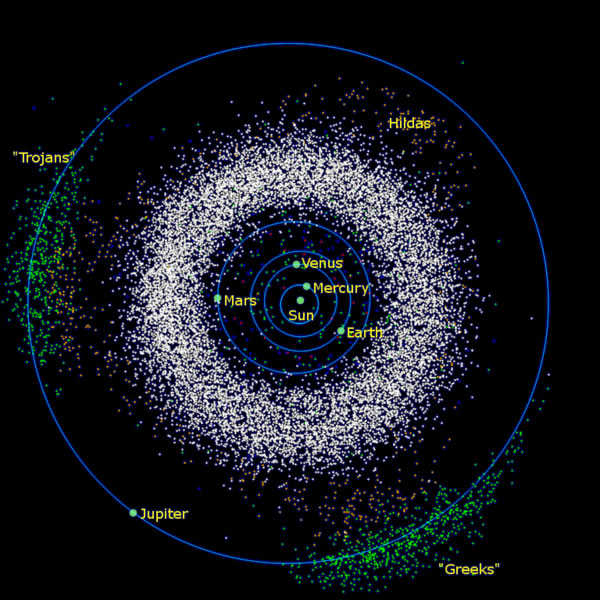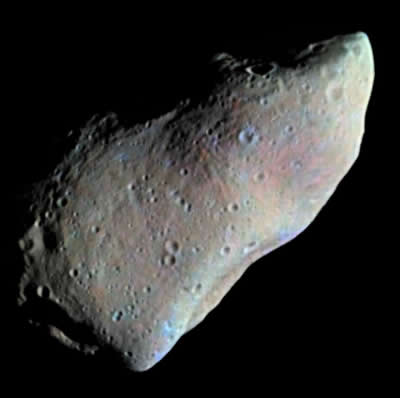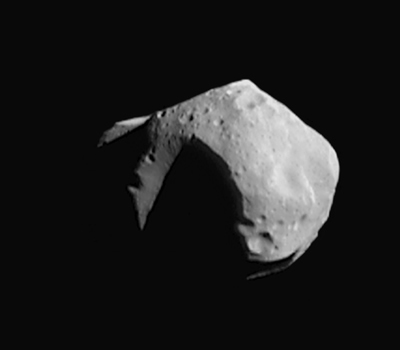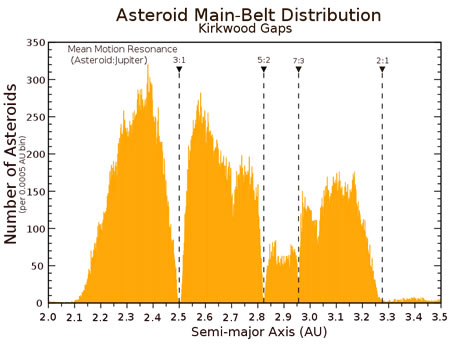Asteroids
In 1766, German astronomers Titius and Bode discovered an interesting numerological pattern that "predicted" the position of the planets. Table 19.2 shows the distance of the planets, and dwarf planet Pluto, from the Sun.
|
 |
|||||||||||||||||||||||||||||||||
| Table 19.2: Distances of planets (including Pluto) from the Sun. | Figure 19.8: Graphical representation of the Titius-Bode "Law". |
Most intriguing is the gap that appears in Table 19.2 in position 5. If the pattern is filled in, the prediction is that a planet should be found at 2.8 AU. By 1800, astronomers were eagerly seeking this "missing planet." In 1801, the discovery appeared to have been made by the Italian astronomer Piazzi with the detection of a star-like object moving against the background of fixed stars. This "new" planet was called Ceres. But in 1802, another "new" planet, called Pallas, was found. And then in 1807, two more... and then ... Get the idea? There was an embarrassment of riches here. In fact, what was discovered was the asteroid belt. The Titius-Bode "Law" is a mere mathematical "fluke," but the asteroids are very real, and your task in this section is to unravel what the asteroids are telling us about the Solar System.
Orbital and Physical Characteristics of Asteroids
Figure 19.9 shows the location of the asteroid belt, which is centred (roughly) 2.8 AU from the Sun. In addition to the main asteroid belt, there are several very important families of asteroids: The Trojan and Greek Asteroids are a group of asteroids that travel around the Sun in an orbital resonance with Jupiter. These asteroids occupy a special location created by the mutual gravitational tug from Jupiter and the Sun. You can see this in the video clip shown below in Figure 19.10. The Hildas are a third group of asteroids that also experience an orbital resonance with Jupiter. In this case, the resonance is a 3:2 resonance — the Hildas orbit 3 times for every 2 orbits of Jupiter. |
 |
| Figure 19.9: The asteroid belt, and Trojan, Hildas, Greek, and near-Earth asteroids. |
Example 19.2: What kind of resonance do the Trojan and Greek asteroids have with Jupiter?
Solution: If you watch the video clip in Figure 19.10, you will see that Jupiter and the Trojan and Greek asteroids orbit at the same rate — they are in a 1:1 resonance.
Figure 19.10: |
Jupiter and Near-Earth Orbiting Asteroids
The planet Jupiter is constantly jostling, tugging, and shepherding asteroids into bands and rings, reminiscent of the way in which the moons of the Jovian planets shepherd the rings of the outer planets. Some of this jostling produces a group of asteroids that travel on highly elliptical orbits that cross the Earth's orbit. These are called the Apollo Asteroids, or Near-Earth Orbiting asteroids (NEOs), or Near-Earth Asteroids (NEAs). Although they make up less than one percent of the known asteroids, astronomers are very interested in them because they have the potential to collide with Earth, which could have disastrous consequences for life on Earth. For this reason, there are a number of international Near-Earth Orbiting Asteroid observation programs in existence, which monitor the sky continuously. The Canada-France-Hawaii Telescope (CFHT) plays an important role in this research.
The Origin of the Asteroids
The asteroids most likely originated from early solar system material that was prevented from forming a planet by the constant disruptive gravitational interaction with Jupiter. The main asteroid belt is situated between 2 AU and 4 AU, and over the history of the solar system, the original material in this part of the solar system underwent a continual process of collision and fragmentation, forming the asteroid belt of today. This also helps astronomers understand why there are 3 primary classes of asteroids: S-type, M-type, and C-type.
S-Type and M-Type These are thought to be fragments produced by larger planetesimals, and consist of crust and mantle material (S-type) and metallic core material (M-type) from planetesimals that had undergone differentiation in the very early solar system. About 20% of the known asteroids are either S-type (about 17%) or M-type. S-type asteroids consist of iron-nickel and silicates, while M-type asteroids are pure iron-nickel in composition. Figure 19.11 shows the asteroid Gaspra, which is an S-type asteroid. C-Type About 75% of the known asteroids are C-type, and are similar to carbonaceous chondrites in their composition (Figure 19.12). These asteroids are found primarily in the outer part of the asteroid belt. Other Asteroid Types Not everything fits into three simple classes, and astronomers have developed an extensive list of sub-classes for asteroids. Notable among these is the asteroid Vesta, which is the second largest body in the asteroid belt and the largest asteroid. It is likely a planetesimal body that survived bombardment with other planetesimals. Vesta is roughly oblong in shape and about 600 km long. There is evidence that Vesta has had a hot interior in its early history, and may have had lava flows on its surface. It is now a cold, inactive object.
|
 |
| Figure 19.11: S-type asteroid Gaspra, as seen by the Galileo spacecraft in 1990. (Image courtesy NASA) | |
 |
|
| Figure 19.12: C-type asteroid Mathilde, imaged by the NEAR spacecraft June 1997. (Image courtesy NASA) |
Example 19.3: Why does it make sense that C-type asteroids are found in the outer part of the asteroid belt?
Solution: This is consistent with the main idea of the condensation sequence: lighter, more volatile materials should condense farther out in the solar nebula where it is colder.
Ceres — A Dwarf Planet
 |
The first asteroid to be discovered is no longer considered to be an asteroid! Ceres was discovered in 1801, and was the first body found in the main asteroid belt. However, Ceres is much larger than virtually all other asteroids, and is roughly spherical. It is now considered to be a dwarf planet, and has the distinction of being the closest dwarf planet to the Sun. Ceres also shows some signs that it may have a more highly differentiated structure than asteroids, and may even contain a layerof frozen water beneath its surface. Figure 19.13 shows a Hubble Space Telescope image of Ceres revealing a body quite different from the asteroids. |
| Figure 19.13: HST image of Ceres. (Image courtesy NASA/HST) |
Example 19.4: After inspecting Figure 19.13, why do you think it is reasonable to classify Ceres as a dwarf planet and not an asteroid?
Solution: One of the criteria required to be a planet is that the body assume a spherical shape under its self-gravitational attraction. This is also true for dwarf planets. Ceres is nearly spherical — it is large enough that its self-gravitation is stronger than the forces that would hold rocks in irregular shapes on lower mass bodies such as asteroids. Ceres, however, cannot be considered a full planet because it has not cleared out the orbital region that it occupies.
Practice
- Discuss a possible connection between M-type, S-type, and C-type asteroids and the kinds of meteorites that we find on Earth.
- Figure 19.11 shows the surface of the asteroid Gaspra. Why, after inspecting this image, would it be reasonable to conclude that Gaspra is a very "old" object?
- Would asteroids be "useful" for mining? What kinds of asteroids would be suitable, and what could you mine?
- The graph shown below depicts the "Kirkwood Gaps." These are specific locations in the asteroid belt in which there are NO asteroids (hence "gaps"). What could have produced this (or is producing this)?
 |
| Figure courtesy NASA |

To understand the origin and characteristics of asteroids, and their place in the SNT.
Chp. 25.2
566-573